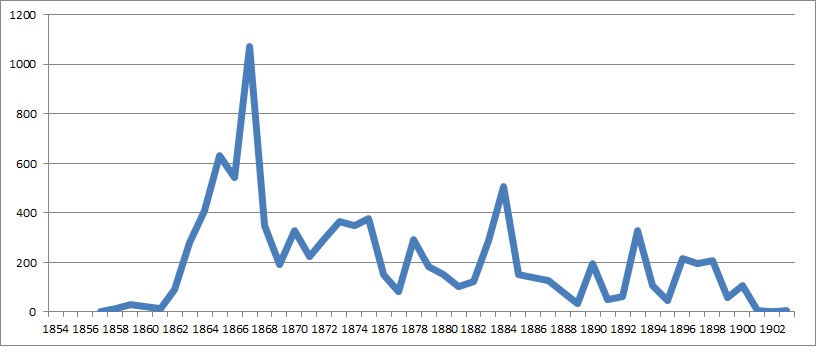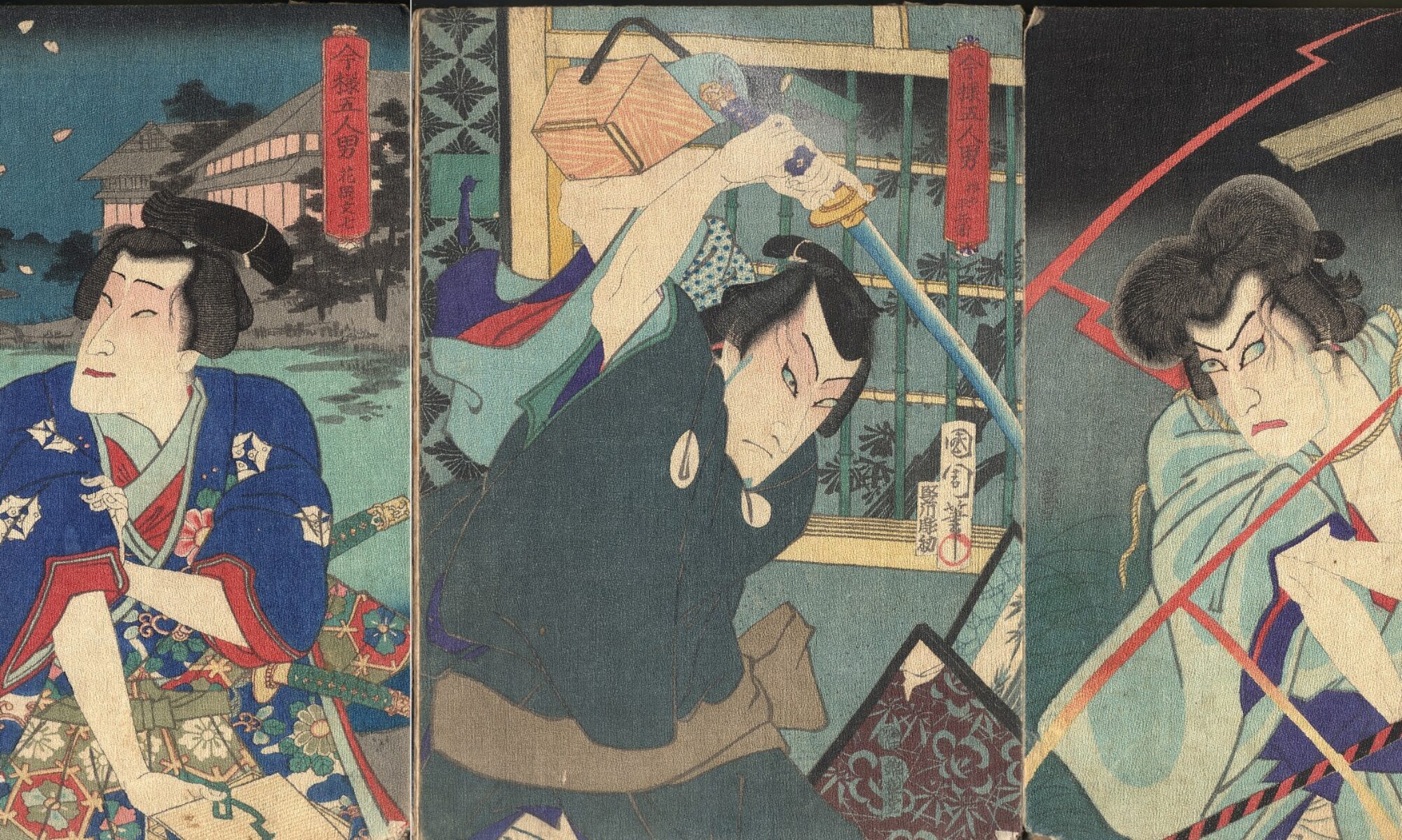Regarding the period from 1852 to 1870, the following was discussed: Changes in the artist’s surname before taking the name Kunichika Toyohara, Seal other than ToshidamaStamp, Ohkubi-e, Ohkao-e, compositions such as medium shots, emotional expressions, manga with exaggerations and omissions, storytellers, etc. Here I will provide a table of contents and an introduction.
.
Table of Contents
Chapter 1 Changes in censor stamps and surveys to confirm the year of issue
Chapter 2 Survey of works from 1852 to 1870
Chapter 3 Discussion on initial activities
3-1 Independence and early activities as an ukiyo-e artist (until 1870)
3-2 Changes in painter’s names
3-3 Toshidama Stamp, Gohishi Stamp, Rakkan
3-4 Landscape paintings
3-5 The establishment of actor face paintings
3-6 The composition of his Ukiyo-e works
3-7 Characteristics of Kunichika’s early works
3-7A) Evaluation so far
3-7B) Characteristics of early works
References
.
Introduction
The activities and evaluation of Toyohara Kunichika as an ukiyo-e artist have already been written by Kojima Usui(1), Inoue Kazuo(2), Sugawara Mayumi(3,4,5,6,22) and Amy Newland(53,54) . Although he left behind a large number of his works, many of them are still overlooked, and he is underestimated as an ukiyo-e artist. Many researchers and evaluators have sought in Kunichika’s works an ukiyo-e comparable to that of the famous ukiyo-e artists Hishikawa Moronobu, Suzuki Harunobu, Utagawa Hiroshige, Toshusai Sharaku, and Kitagawa Utamaro. Because it was a summary of such results and it was fragmentary. In other words, it was an evaluation method that asked whether there was a work within the category of ukiyo-e established as art held by the evaluator.
Kunichika’s works were very popular in the ukiyo-e subculture of the late Edo and Meiji periods. I thought I would try to grasp Kunichika’s characteristics by examining his early works, since it is believed that the basic style and ideas of any artist are born in their early creative activities. I examined his early works from three fields: illustrations such as kusazoshi, fan paintings, and ukiyo-e, which have been preserved and recently exhibited to the public. I thought I could understand Kunichika’s creative activities and transitions by examining his activities as an artist in these fields. As I will explain later, Toyokuni III has the most preserved works in the world, followed by Hiroshige, and Kunichika is third, with over 10,000 works preserved throughout his lifetime, which I thought would be sufficient for the investigation.
Regarding materials, I used the following databases for each field.
1) Illustrations and ancient documents
There are cases in which popular books were republished by different publishers, reissued later with different titles, or bound during the Meiji period after many years. Since reissues in later years often lack cover pages compared to early ones, early publications were searched for as much as possible. Here, the year and month in which the illustration was drawn was determined from the date drawn in the preface of the book, the publication information on the final page, and the format of the Censor Stamp stamped outside the frame in the text. Regarding this Censor Stamp style, Ishi Kendo’s “Review of Nishiki-e’s Censor Stamp” and other(7,8) were used as a reference.
For illustrations, I referred to the website of the Ukiyo-e Literature Museum on the Internet (https://www.ne.jp/asahi/kato/yoshio/index.html :opened on September 11, 2005, edited and produced by Kato Yoshio加藤 好夫). The specific details of each are discussed here based on data obtained by searching old documents published by the National Diet Library Digital, Waseda University, Ritsumeikan University, other museums, and municipal libraries nationwide and confirming them with images. In addition, materials such as books that have not been released to the public were visited and examined. The databases used are as follows.
Union Catalogue Database of Japanese Texts
Modern Bibliography/Modern Image Database
Rare Books Comprehensive Database (Waseda University)
https://www.wul.waseda.ac.jp/kotenseki/
Waseda University Theater Museum Theater Information Comprehensive Database
https://www.waseda.jp/enpaku/db/
ARC Classics Portal Database
https://jpsearch.go.jp/database/arc_books
National Diet Library Digital Collections
The British Museum’s Collection of Japanese Classical Books Browsing System
https://www.dh-jac.net/db1/books/search_bm.php
The illustrations are classified into Gokanbon, Kusazoushi, Akahon, Kiritsukehon, Fukuroirihon, etc., according to the form of the book and the target audience. Since the purpose is to examine the illustrations and pictures drawn by Kunichika in chronological order, they are treated as kusazoshi regardless of these classifications. In addition, there are materials that are believed to have been published in the Edo period and bound in the Meiji period, so there are many cases where the details such as the picture on the back cover are unknown unless the first edition is searched. There is also a description that “I drew a picture on a hancho”. To put it simply, 5 pages of Kusazoshi are one volume, and several volumes make up one story. In addition, several volumes are bound together and decorated with nishiki-e (color woodblock prints). One sheet of paper is folded in half and bound, so a hancho is equivalent to one modern page. The year of publication is usually given in the preface. In some cases, it may take several years for a book to be published after it has been censored after drawing a picture, so naturally the illustration was drawn before the date of publication. As for when the illustration was drawn, fortunately, the blank space above the text is stamped with a censor stamp in the same style as ukiyo-e, so it is possible to determine the year in which it was drawn.
2) Uchiwa-e (Fan Paintings)
As a result of searching the National Diet Library digitally, there were three books of Uchiwa-e related image data that collected Uchiwa paintings, but Kunichika’s Uchiwa painting images appeared in two books. John’s ukiyo-e search (described later) found about 20 pieces, but there were no digital publications like the uchiwa-e album stored in the National Diet Library. There may be other uchiwa-e that have not been published yet. The year in which uchiwa-e was drawn was confirmed with the Suhama Stamp, and the style of the Suhama Stamp was based on the ukiyo-e Censor Stamp style.
A. Yakusha Nigaho-e Uchiwa (National Diet Library access number 237-376)
All paintings by Kunisada
https://dl.ndl.go.jp/pid/9369194/1/1
B. Haiyu Uchiwa-e (National Diet Library access No. 237-377)
A total of 155 works by Toyokuni, Kuniyoshi, Kunichika, and Fusatane. Among them, 26 works by Kunichika
https://dl.ndl.go.jp/pid/9369201/1/1
C. Uchiwa-e (National Diet Library Call Number Special 56-37)
Poor image quality in black and white. Includes works by Kunichika and others, 33 uchiwa-es for Kunichika, 66 works on the front and back, works from 1872 onwards as there is no Aratame Stamp
https://dl.ndl.go.jp/pid/854293/1/1
3) Ukiyo-e
“Ukiyo-e Search” https://ja.ukiyo-e.org/
John’s ukiyo-e search is mainly used because it is possible to search for ukiyo-e that are stored in museums around the world. Regarding the details of ukiyo-e, images, Censor Stamps, etc. were confirmed by directly searching the database of each ukiyo-e preservation organization. In other words, the databases used to investigate the details are Waseda University Theater Museum Digital, Waseda University Library, Tokyo Metropolitan Library, ARC portal site (Ritsumeikan University database), National Diet Library Digital, The Boston Museum of Fine Arts, British Museum, etc. Art museums and museums have announced their works by specifying the period, but particularly important early works were confirmed with censor stamps, and then compiled by year. In addition, when the actor’s name was listed, the year of activity was confirmed.
In addition, regarding the publishers and carvers of ukiyo-e works, refer to the section “Carver and Printer”(9) and “Publisher of Ukiyo-e Prints”(10) in the Encyclopedia of Primary Color Ukiyo-e, Volume 3, Taishukan, 1982, edited by the Japan Ukiyo-e Association. The Kabuki actor’s Meiseki identity period was examined in the ARC Portal Database’s “Bulletin and Entertainer Personal Name Database”.
Investigation of Kunichika’s active period as a painter
Looking at the total number of works left behind by each ukiyo-e artist, the number of ukiyo-e prints by Toyokuni, Kunichika, and others is enormous. The total number of ukiyo-e prints owned by various museums is considered to be correlated with the number of prints and popularity at the time. Looking at the number of ukiyo-e owned by Waseda University Theater Museum Digital, Tokyo Metropolitan Library and ARC Portal Database (Ritsumeikan University), Kunisada & Toyokuni III topped the list with 27,115, Hiroshige(include Hirosige II) was second with 11,052, Toyohara Kunichika was third with 10,010, and Kuniyoshi was fourth with 4,095. In modern times, Kunichika is regarded as one of the low-class painters who produced mass production, and his reputation is low. However, looking at these numbers, it seems that in the past, ukiyo-e prints such as Kunichika’s yakusha-e were much more popular and acclaimed than we think. Therefore, I used the “Ukiyo-e Search” to check the number of ukiyo-e prints that Kunichika painted throughout his life that are currently in storage. Ukiyo-e owned by domestic organizations and ukiyo-e owned by overseas organizations are often different, such as ukiyo-e owned by overseas organizations but not in Japan, so ukiyo-e search can see the whole. However, while certain organizations overseas such as The Boston Museum of Fine Arts, make sound judgments regarding the dates of creation of works, there are works that are incorrect, such as Eto’s judgment regarding censor stamps. Nevertheless, even with such errors included, a general trend was determined. Although not shown here, the patterns and peaks matched even when compared with a graph created using only the data from the Waseda University Theater Museum and the ARC portal site (Ritsumeikan University).
Looking at this figure, the number of works (popularity) in storage increased from around 1862, and in 1867 he became a popular painter with a huge number of more than 1000 works. Although he declined thereafter, his work remained fairly stable until his death in 1900. For this reason, his works up to 1870 were investigated as his early works.

The number of ukiyo-e prints drawn by Kunichika in storage: data from ukiyo-e search
.
I obtained data on Kusazoshi, Uchiwa-e, Ukiyo-e from the following organizations through the Internet. Also, I visited and got some image. All Kunichika’s works are now in the public domain, but I am grateful that they have been stored and managed so far, and that they have been freely browsed on the Internet.
Waseda University Theater Museum Waseda University Library
Tokyo Metropolitan Library ARC Portal Site (Ritsumeikan University)
National Diet Library Senshu University Library
Fukui Prefectural Library Noda City Library
Boston Museum of Fine Arts British Museum
University of Wisconsin-Madison Kunitachi College of Music
Tokyo National Museum Japan Art Open Database
Fine Art Museum of San Francisco Akita Prefectural Library
Kyoto University of the Aarts, Geijutsu-kan Tokyo University of the arts
Nakano City Museum of History and Folklore, Tokyo
Japan Art Open Database Victoria and Albert Museum, London
Other organizations that released data through the national book databa
